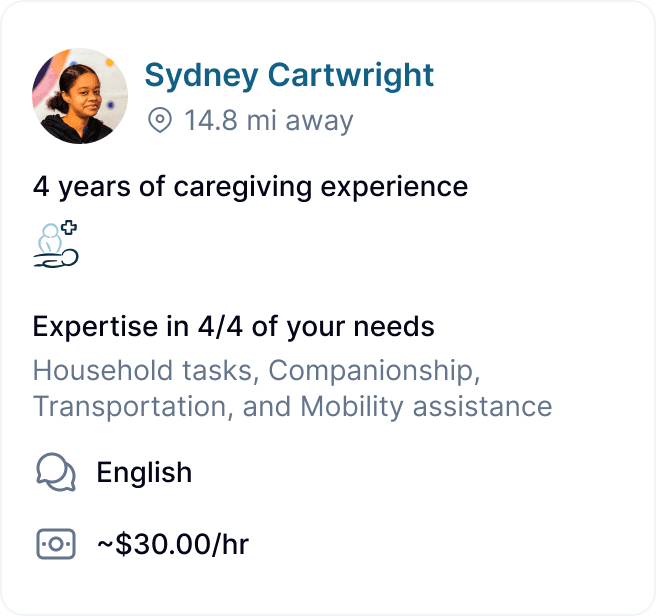Part-Time, Full-Time, Overnight, Split-Shift, Or Live-In: What Kind Of Care Schedule Do I Need?



Choosing the right home care schedule for yourself or a loved one is a crucial decision—one that balances personal needs, family routines, and budget. Whether you’re seeking help just on weekends, need someone overnight, require flexible split-shift coverage, or are considering part-time, full-time, or live-in support, understanding your options can help you make the best choice.
In this post, we’ll break down the most common care schedules available, their benefits, and how modern home care platforms like Clara can help you find the right fit.
Understanding Care Schedules: The Main Options
When it comes to in-home care, flexibility is key. Here are six of the most popular scheduling arrangements:
1. Part-Time Care
Part-time care typically involves a caregiver visiting for a few hours each day, totaling around 20 hours per week. This is a popular choice for families who need regular assistance but not around-the-clock supervision.
Benefits:
Flexible and cost-effective for those who need help with daily routines, errands, or companionship.
Allows family caregivers to balance work or other responsibilities.
Ideal for individuals who are mostly independent but benefit from some assistance.
Considerations:
May not be sufficient for those with complex medical needs or who require 24/7 supervision.
Scheduling consistency is important to build trust and routine.
New to the idea of home care? Check out our simple guide to home care for families.
2. Full-Time Care
Full-time care usually means a caregiver is present for 9 hours a day, 5 to 7 days a week. This is suited for individuals who need comprehensive support throughout the day but do not require overnight or live-in care.
Benefits:
Comprehensive assistance with personal care, mobility, medication, meals, and household tasks.
Provides family caregivers with significant respite.
Promotes safety and well-being for those with higher care needs.
Considerations:
More costly than part-time care, but often less expensive than facility-based care.
May require multiple caregivers to cover all shifts.
3. Live-In Care
Live-in care involves a caregiver residing in the client’s home, providing support as needed throughout the day and night. This is the most intensive form of in-home care and is ideal for those who need round-the-clock supervision and assistance.
Benefits:
24/7 care and companionship, which is especially important for those with dementia, mobility issues, or chronic illness.
Allows individuals to remain in the comfort of their own home.
Builds a strong, trusting relationship between caregiver and client.
Considerations:
The caregiver must have their own private space and time for rest.
Costs are higher, but can be comparable to assisted living or nursing home care.
Some agencies, including Clara Home Care, handle the logistics, payroll, and legal requirements for live-in arrangements.
4. Weekend-Only Care
Weekend-only care is ideal for families who can provide support during the week but need extra help on Saturdays and Sundays.
Benefits:
Provides respite for family caregivers, reducing burnout.
Ensures continuity of care during periods when regular support is unavailable.
5. Overnight Care
Overnight care is essential for individuals who need support during nighttime hours—whether due to medical needs, anxiety, or safety concerns such as fall risk or wandering (common in dementia).
Types of Overnight Care:
Sleeping Night Care: The caregiver sleeps at the home and is available for occasional assistance.
Waking Night Care: The caregiver is awake and alert throughout the night, providing hands-on support as needed.
Sitting Service: Offers short-term overnight respite for family caregivers.
Benefits:
Provides peace of mind for families.
Reduces risk of falls or accidents during the night.
Supports better sleep and well-being for both the care recipient and their family.
6. Split-Shift Care
Split-shift scheduling divides the workday into two or more segments, separated by a long break. For example, a caregiver might work from 7:00–11:00 am and then return from 5:00–9:00 pm, covering both morning and evening routines.
Benefits:
Maximizes support during peak need times.
Allows family caregivers to manage midday hours or work commitments.
Can be more cost-effective than full-day coverage if only certain times require assistance.
How to Choose the Right Schedule For Your Loved One
Assess Needs: Consider when help is most needed—mornings, evenings, overnight, weekends, or all day.
Family Availability: Factor in when family members can provide care and when outside help is essential.
Budget: Some schedules may be more affordable, especially if you only need help during specific times.
Flexibility: Look for a provider or platform that allows you to adjust your schedule as needs change. Flexibility is a key reason families elect to directly employer a caregiver, rather than using a home care agency, which you can learn more about here.
Conclusion
Choosing the right care schedule is about more than just filling hours—it’s about supporting your loved one’s independence, safety, and quality of life while also giving family caregivers the respite and flexibility they need. Whether you need help on weekends, overnight, part-time, full-time, live-in, or at split times throughout the day, today’s home care options are more flexible and accessible than ever.
Platforms like Clara Home Care make it easy to find the right caregiver, set your preferred schedule, and adjust as your needs evolve. With transparent pricing, fast placement, and dedicated support, you can focus on what matters most: caring for your loved one and maintaining your family’s well-being.
If you’re exploring care options, consider your family’s unique needs and don’t hesitate to reach out for a personalized consultation. The right schedule—and the right caregiver—can make all the difference.
Choosing the right home care schedule for yourself or a loved one is a crucial decision—one that balances personal needs, family routines, and budget. Whether you’re seeking help just on weekends, need someone overnight, require flexible split-shift coverage, or are considering part-time, full-time, or live-in support, understanding your options can help you make the best choice.
In this post, we’ll break down the most common care schedules available, their benefits, and how modern home care platforms like Clara can help you find the right fit.
Understanding Care Schedules: The Main Options
When it comes to in-home care, flexibility is key. Here are six of the most popular scheduling arrangements:
1. Part-Time Care
Part-time care typically involves a caregiver visiting for a few hours each day, totaling around 20 hours per week. This is a popular choice for families who need regular assistance but not around-the-clock supervision.
Benefits:
Flexible and cost-effective for those who need help with daily routines, errands, or companionship.
Allows family caregivers to balance work or other responsibilities.
Ideal for individuals who are mostly independent but benefit from some assistance.
Considerations:
May not be sufficient for those with complex medical needs or who require 24/7 supervision.
Scheduling consistency is important to build trust and routine.
New to the idea of home care? Check out our simple guide to home care for families.
2. Full-Time Care
Full-time care usually means a caregiver is present for 9 hours a day, 5 to 7 days a week. This is suited for individuals who need comprehensive support throughout the day but do not require overnight or live-in care.
Benefits:
Comprehensive assistance with personal care, mobility, medication, meals, and household tasks.
Provides family caregivers with significant respite.
Promotes safety and well-being for those with higher care needs.
Considerations:
More costly than part-time care, but often less expensive than facility-based care.
May require multiple caregivers to cover all shifts.
3. Live-In Care
Live-in care involves a caregiver residing in the client’s home, providing support as needed throughout the day and night. This is the most intensive form of in-home care and is ideal for those who need round-the-clock supervision and assistance.
Benefits:
24/7 care and companionship, which is especially important for those with dementia, mobility issues, or chronic illness.
Allows individuals to remain in the comfort of their own home.
Builds a strong, trusting relationship between caregiver and client.
Considerations:
The caregiver must have their own private space and time for rest.
Costs are higher, but can be comparable to assisted living or nursing home care.
Some agencies, including Clara Home Care, handle the logistics, payroll, and legal requirements for live-in arrangements.
4. Weekend-Only Care
Weekend-only care is ideal for families who can provide support during the week but need extra help on Saturdays and Sundays.
Benefits:
Provides respite for family caregivers, reducing burnout.
Ensures continuity of care during periods when regular support is unavailable.
5. Overnight Care
Overnight care is essential for individuals who need support during nighttime hours—whether due to medical needs, anxiety, or safety concerns such as fall risk or wandering (common in dementia).
Types of Overnight Care:
Sleeping Night Care: The caregiver sleeps at the home and is available for occasional assistance.
Waking Night Care: The caregiver is awake and alert throughout the night, providing hands-on support as needed.
Sitting Service: Offers short-term overnight respite for family caregivers.
Benefits:
Provides peace of mind for families.
Reduces risk of falls or accidents during the night.
Supports better sleep and well-being for both the care recipient and their family.
6. Split-Shift Care
Split-shift scheduling divides the workday into two or more segments, separated by a long break. For example, a caregiver might work from 7:00–11:00 am and then return from 5:00–9:00 pm, covering both morning and evening routines.
Benefits:
Maximizes support during peak need times.
Allows family caregivers to manage midday hours or work commitments.
Can be more cost-effective than full-day coverage if only certain times require assistance.
How to Choose the Right Schedule For Your Loved One
Assess Needs: Consider when help is most needed—mornings, evenings, overnight, weekends, or all day.
Family Availability: Factor in when family members can provide care and when outside help is essential.
Budget: Some schedules may be more affordable, especially if you only need help during specific times.
Flexibility: Look for a provider or platform that allows you to adjust your schedule as needs change. Flexibility is a key reason families elect to directly employer a caregiver, rather than using a home care agency, which you can learn more about here.
Conclusion
Choosing the right care schedule is about more than just filling hours—it’s about supporting your loved one’s independence, safety, and quality of life while also giving family caregivers the respite and flexibility they need. Whether you need help on weekends, overnight, part-time, full-time, live-in, or at split times throughout the day, today’s home care options are more flexible and accessible than ever.
Platforms like Clara Home Care make it easy to find the right caregiver, set your preferred schedule, and adjust as your needs evolve. With transparent pricing, fast placement, and dedicated support, you can focus on what matters most: caring for your loved one and maintaining your family’s well-being.
If you’re exploring care options, consider your family’s unique needs and don’t hesitate to reach out for a personalized consultation. The right schedule—and the right caregiver—can make all the difference.
Choosing the right home care schedule for yourself or a loved one is a crucial decision—one that balances personal needs, family routines, and budget. Whether you’re seeking help just on weekends, need someone overnight, require flexible split-shift coverage, or are considering part-time, full-time, or live-in support, understanding your options can help you make the best choice.
In this post, we’ll break down the most common care schedules available, their benefits, and how modern home care platforms like Clara can help you find the right fit.
Understanding Care Schedules: The Main Options
When it comes to in-home care, flexibility is key. Here are six of the most popular scheduling arrangements:
1. Part-Time Care
Part-time care typically involves a caregiver visiting for a few hours each day, totaling around 20 hours per week. This is a popular choice for families who need regular assistance but not around-the-clock supervision.
Benefits:
Flexible and cost-effective for those who need help with daily routines, errands, or companionship.
Allows family caregivers to balance work or other responsibilities.
Ideal for individuals who are mostly independent but benefit from some assistance.
Considerations:
May not be sufficient for those with complex medical needs or who require 24/7 supervision.
Scheduling consistency is important to build trust and routine.
New to the idea of home care? Check out our simple guide to home care for families.
2. Full-Time Care
Full-time care usually means a caregiver is present for 9 hours a day, 5 to 7 days a week. This is suited for individuals who need comprehensive support throughout the day but do not require overnight or live-in care.
Benefits:
Comprehensive assistance with personal care, mobility, medication, meals, and household tasks.
Provides family caregivers with significant respite.
Promotes safety and well-being for those with higher care needs.
Considerations:
More costly than part-time care, but often less expensive than facility-based care.
May require multiple caregivers to cover all shifts.
3. Live-In Care
Live-in care involves a caregiver residing in the client’s home, providing support as needed throughout the day and night. This is the most intensive form of in-home care and is ideal for those who need round-the-clock supervision and assistance.
Benefits:
24/7 care and companionship, which is especially important for those with dementia, mobility issues, or chronic illness.
Allows individuals to remain in the comfort of their own home.
Builds a strong, trusting relationship between caregiver and client.
Considerations:
The caregiver must have their own private space and time for rest.
Costs are higher, but can be comparable to assisted living or nursing home care.
Some agencies, including Clara Home Care, handle the logistics, payroll, and legal requirements for live-in arrangements.
4. Weekend-Only Care
Weekend-only care is ideal for families who can provide support during the week but need extra help on Saturdays and Sundays.
Benefits:
Provides respite for family caregivers, reducing burnout.
Ensures continuity of care during periods when regular support is unavailable.
5. Overnight Care
Overnight care is essential for individuals who need support during nighttime hours—whether due to medical needs, anxiety, or safety concerns such as fall risk or wandering (common in dementia).
Types of Overnight Care:
Sleeping Night Care: The caregiver sleeps at the home and is available for occasional assistance.
Waking Night Care: The caregiver is awake and alert throughout the night, providing hands-on support as needed.
Sitting Service: Offers short-term overnight respite for family caregivers.
Benefits:
Provides peace of mind for families.
Reduces risk of falls or accidents during the night.
Supports better sleep and well-being for both the care recipient and their family.
6. Split-Shift Care
Split-shift scheduling divides the workday into two or more segments, separated by a long break. For example, a caregiver might work from 7:00–11:00 am and then return from 5:00–9:00 pm, covering both morning and evening routines.
Benefits:
Maximizes support during peak need times.
Allows family caregivers to manage midday hours or work commitments.
Can be more cost-effective than full-day coverage if only certain times require assistance.
How to Choose the Right Schedule For Your Loved One
Assess Needs: Consider when help is most needed—mornings, evenings, overnight, weekends, or all day.
Family Availability: Factor in when family members can provide care and when outside help is essential.
Budget: Some schedules may be more affordable, especially if you only need help during specific times.
Flexibility: Look for a provider or platform that allows you to adjust your schedule as needs change. Flexibility is a key reason families elect to directly employer a caregiver, rather than using a home care agency, which you can learn more about here.
Conclusion
Choosing the right care schedule is about more than just filling hours—it’s about supporting your loved one’s independence, safety, and quality of life while also giving family caregivers the respite and flexibility they need. Whether you need help on weekends, overnight, part-time, full-time, live-in, or at split times throughout the day, today’s home care options are more flexible and accessible than ever.
Platforms like Clara Home Care make it easy to find the right caregiver, set your preferred schedule, and adjust as your needs evolve. With transparent pricing, fast placement, and dedicated support, you can focus on what matters most: caring for your loved one and maintaining your family’s well-being.
If you’re exploring care options, consider your family’s unique needs and don’t hesitate to reach out for a personalized consultation. The right schedule—and the right caregiver—can make all the difference.
More about finding care
More about finding care


What Does a Typical Caregiver Schedule Look Like and What Can You Personalize?



Vanessa Bustos


Six Steps To Finding A Culturally Compatible Caregiver



Vanessa Bustos


What Benefits Should I Offer a Private Caregiver?



Vanessa Bustos


How to Vet an Independent Caregiver Without an Agency



Clara Editorial Team


Hiring for Flexibility: Matching a Care Schedule to Your Loved One’s Life



Vanessa Bustos


How to Check Senior Caregiver References and What Questions to Ask



Vanessa Bustos


What Is the Average Cost of Nursing Home Care in California?



Jon Levinson


How Do I Find A Reliable Private Caregiver?



Vanessa Bustos


Navigating the Choices: Private In-Home Caregivers vs. Agency Care



Lowrie Hilladakis


Can a Dementia Patient Be Cared for at Home?



Lowrie Hilladakis
GEt started for free
Better care starts with Clara.
Find, hire, and pay top-notch caregivers without the headache for a price that fits your budget.



GEt started for free
Better care starts with Clara.
Find, hire, and pay top-notch caregivers without the headache for a price that fits your budget.



GEt started for free
Better care starts with Clara.
Find, hire, and pay top-notch caregivers without the headache for a price that fits your budget.

